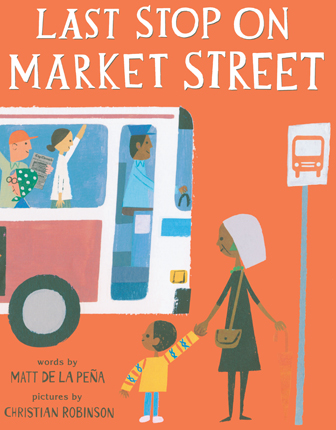| Last stop on Market Street Author: de la Pena, Matt | ||
| Price: $23.78 | ||
Summary:
A young boy rides the bus across town with his grandmother and learns to appreciate the beauty in everyday things.
| Illustrator: | Robinson, Christian |
Video Preview:
| Accelerated Reader Information: Interest Level: LG Reading Level: 3.30 Points: .5 Quiz: 171387 | Reading Counts Information: Interest Level: K-2 Reading Level: 2.40 Points: 1.0 Quiz: 65126 | |
Awards:
Caldecott Honor, 2016
Newbery Award, 2016
Coretta Scott King Illustrator Honor, 2016
Reviews:
Kirkus Reviews (+) (11/01/14)
School Library Journal (11/01/14)
Booklist (02/01/15)
The Bulletin of the Center for Children's Books (02/15)
The Hornbook (+) (00/03/15)
Full Text Reviews:
School Library Journal - 11/01/2014 K-Gr 2—After church on Sundays, CJ and his nana wait for the bus. It's a familiar routine, but this week CJ is feeling dissatisfied. As they travel to their destination, the boy asks a series of questions: "How come we gotta wait for the bus in all this wet?" "Nana, how come we don't got a car?" "How come we always gotta go here after church?" CJ is envious of kids with cars, iPods, and more freedom than he has. With each question, Nana points out something for CJ to appreciate about his life: "Boy, what do we need a car for? We got a bus that breathes fire." These gentle admonishments are phrased as questions or observations rather than direct answers so that CJ is able to take ownership of his feelings. After they exit the bus, CJ wonders why this part of town is so run-down, prompting Nana to reply, "Sometimes when you're surrounded by dirt, CJ, you're a better witness for what's beautiful." The urban setting is truly reflective, showing people with different skin colors, body types, abilities, ages, and classes in a natural and authentic manner. Robinson's flat, blocky illustrations are simple and well composed, seemingly spare but peppered with tiny, interesting details. Ultimately, their destination is a soup kitchen, and CJ is glad to be there. This is an excellent book that highlights less popular topics such as urban life, volunteerism, and thankfulness, with people of color as the main characters. A lovely title.—Anna Haase Krueger, Ramsey County Library, MN - Copyright 2014 Publishers Weekly, Library Journal and/or School Library Journal used with permission.
Booklist - 02/01/2015 CJ and his nana depart church and make it to the bus stop just in time to avoid an oncoming rain shower. They board the bus, and while CJ is full of questions and complaints (why don’t they have a car? why must they make this trip every week? and so forth), Nana’s resolute responses articulate the glories of their rich, vibrant life in the city, as presented by the bus’ passengers and passages. A tattooed man checks his cell phone. An older woman keeps butterflies in a jar. A musician tunes and plays his guitar. At last the pair arrive at the titular destination and proceed to the soup kitchen where, upon recognizing friendly faces, CJ is glad they came to help. Robinson’s bright, simple, multicultural figures, with their rounded heads, boxy bodies, and friendly expressions, contrast nicely with de la Peña’s lyrical language, establishing a unique tone that reflects both CJ’s wonder and his nana’s wisdom. The celebratory warmth is irresistible, offering a picture of community that resonates with harmony and diversity. - Copyright 2015 Booklist.
Bulletin for the Center... - 02/01/2015 As little CJ bounds out the church doors on Sunday morning, “the outside air smelled like freedom,” so he’s more than a little miffed by the fact his grandmother has further plans for his day. CJ is something of a whiner, but for every complaint, Nana has an answer. Too rainy? It looks like the tree is drinking through a straw. His friends get car rides? Well, they don’t get to meet people on the bus. What’s up with the blind guy in sunglasses on the bus? “Boy, what do you know about seeing? . . . Some people watch the world with their ears.” Their destination only makes things seem worse-the “crumbling sidewalks and broken-down doors, graffiti-tagged windows and boarded-up stores.” Once CJ and his nana settle in to their weekly job, working at a soup kitchen, the boy admits he’s glad they came. As in Maribeth Boelts’ Those Shoes (BCCB 12/07), this young protagonist comes around to realize that poverty is relative, and that while he envies the greener grass on the other side of the fence, his life looks verdant to people in true need. Bright colors and streamlined shapes keep the urban setting and its denizens cheerful, emphasizing the positive message rather than the neighborhood’s seediness; the multicultural, multi-age cast of extras underscores the fact that want crosses demographics, and that there’s no shame in benefiting from a free meal. CJ is a completely believable little guy in both his natural desire to set his own agenda and his tacit admission that doing good feels good. This is a lesson that goes down easy. EB - Copyright 2015 The Board of Trustees of the University of Illinois.



